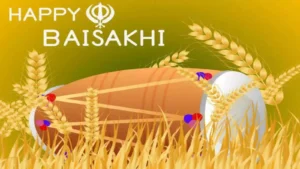Baisakhi: A Festival of Joy, Prosperity and New Beginnings
 Baisakhi, also known as Vaisakhi, is one of the most widely celebrated festivals in India, marking the beginning of the harvest season in the northern parts of the country. Celebrated on April 13th or 14th each year, Baisakhi holds deep cultural, agricultural, and religious significance, particularly in Punjab and other northern states. It is a time of joy, gratitude, and festivity, as people give thanks for the bountiful harvest and pray for prosperity in the year to come.
Baisakhi, also known as Vaisakhi, is one of the most widely celebrated festivals in India, marking the beginning of the harvest season in the northern parts of the country. Celebrated on April 13th or 14th each year, Baisakhi holds deep cultural, agricultural, and religious significance, particularly in Punjab and other northern states. It is a time of joy, gratitude, and festivity, as people give thanks for the bountiful harvest and pray for prosperity in the year to come.
Beyond its agricultural roots, Baisakhi also has great spiritual importance, especially for Sikh communities. On this day in 1699, Guru Gobind Singh Ji, the tenth Sikh Guru, founded the Khalsa Panth, an important event in Sikh history that led to the strengthening of the Sikh identity.
The festival is celebrated with traditional dances like Bhangra and Gidda, colorful processions, and prayers. People visit gurudwaras (Sikh temples), offering prayers and participating in kirtans (devotional singing). It is a time for family gatherings, feasts, and expressing gratitude for nature’s abundance.
In this blog, we explore the rich significance of Baisakhi, its cultural roots, spiritual meaning, and how it unites people in celebration across India. Whether you are celebrating for the harvest, the history, or the spiritual heritage, Baisakhi brings communities together in harmony and joy.
Why do we Celebrate Baisakhi?
Baisakhi is celebrated for a variety of cultural, agricultural, and spiritual reasons, each holding great significance in Indian traditions. The festival, which typically falls on April 13th or 14th every year, is observed with great enthusiasm, particularly in the northern states of India like Punjab, Haryana, and Uttar Pradesh. Here’s why Baisakhi is celebrated:
1. Celebrating the Harvest Season
- Baisakhi marks the beginning of the harvest season in the northern states of India. It is a time to celebrate the successful harvesting of crops, especially wheat, and express gratitude for nature’s abundance. Farmers offer prayers for a bountiful harvest in the coming year. The festival is often associated with the Rabi crop harvest, and the sight of golden fields of wheat symbolizes prosperity and abundance.
2. Spiritual Significance in Sikhism
- For Sikhs, Baisakhi holds great religious importance. It was on this day in 1699, the tenth Sikh Guru, Guru Gobind Singh Ji, established the Khalsa Panth, a community of initiated Sikhs. The creation of the Khalsa was a significant moment in Sikh history, symbolizing the defense of righteousness, equality, and justice. This day is commemorated with great reverence in gurudwaras (Sikh temples) through special prayers and ceremonies.
3. Symbol of Unity and Strength
- Baisakhi also serves as a reminder of the unity and strength of the Sikh community. The founding of the Khalsa created a distinct identity for Sikhs, one that emphasized spiritual discipline, equality, and social responsibility. The day is celebrated as a symbol of courage, unity, and faith, and Sikhs across the world come together to honor this important moment in their history.
4. Cultural Festivities and Traditions
- Baisakhi is not only a time for prayer and reflection but also a festival of joyful celebrations. In Punjab, it is marked by vibrant Bhangra and Gidda dances, processions, and street fairs. People dress in bright colors, enjoy traditional music and food, and participate in various community events. The festival brings communities together and fosters a spirit of togetherness and celebration.
5. Welcoming the New Year in Some Regions
- In some regions of India, Baisakhi is celebrated as the New Year. It is known as Vaisakhi in parts of Himachal Pradesh and Uttarakhand, marking the start of a new cycle. It also coincides with other regional new year celebrations like Pohela Boishakh in Bengal. This adds an extra layer of significance, as people celebrate the beginning of a new year with hope and optimism.
6. A Day of Reflection and Gratitude
- Baisakhi is also a day for people to reflect on the past year, give thanks for their blessings, and seek peace and prosperity for the coming year. Whether through prayers, family gatherings, or community service, it’s a time for expressing gratitude for the harvest, personal achievements, and the health of loved ones.
In summary, Baisakhi is celebrated to honor the harvest season, commemorate the establishment of the Khalsa in Sikhism, and bring communities together in a spirit of joy and unity. It holds deep spiritual, agricultural, and cultural significance, making it one of the most vibrant and meaningful festivals in India.
Significance of Baisakhi in Sikhism
Baisakhi is of major importance for the people following the Sikh faith.
As it was on Baisakhi Day, in the year 1699 the Tenth Guru of Sikhs, Guru Gobind Singh founded Khalsa Panth or the Order of Pure Ones and gave a unique identity to Sikhs.
On the same day, the guru administered Amrit (nectar) to his first batch of five disciples making them Singh.
a martial community. By doing so, he eliminated the differences between high and low and established that all human beings were equal.
Sikhs celebrate Baisakhi by participating in special prayer meetings organized at gurdwaras.
They also carry out joyful Baisakhi processions to mark the day.
Which states celebrates Baisakhi?
Significance of Baisakhi in Other Religions
The day of Baisakhi is of significance for the Hindus as it was on this day in 1875
Swami Dayanand Saraswati founded the Arya Samaj – a reformed sect of Hindus who are devoted to the Vedas for spiritual guidance and have discarded idol worship.
Besides, Baisakhi day is of relevance for the Buddhists as Gautama Buddha attained enlightenment and Nirvana on this auspicious day.
massage
Sunhari dhup barsat ke bad, search thodi si khushi har baat ke baad, usi tarah ho mubarak aap ko ye nayi subah kal raat ke baad. Happy Baisakhi!!
May this Baisakhi carry prosperity of luck and oceans of delight in your life. Happy Baisakhi!
Has deyon Doston nu hasaan vaaste, cialis 40mg Marr java Doston ko manaan vaaste, Baisakhi hai khushi manaan vaaste,
Baisakhi ki vadhiyan saare parivar nu. Happy Baisakhi
Ajj De Din, hospital 310 Saal Pehla, prescription 1699 Di Vaisaki Nu Guru Gobind Singh Ji Ne Anandpur Sahib Vikhe Amrit Chakkaya Atte KHALSA PANTH nu Janam ditta.
**Happy Baisakhi**
Conclusion:
Baisakhi becomes an important festival for two religions which is very rare.
The knowledge of reasons behind celebrating a particular festival helps people in
understanding the rituals as well as their religion in a better manner.
Once we understand our religion and its auspiciousness, we naturally start taking pride in it and following it with all our hearts.
This is some knowledge about what Vaisakhi is and why it is celebrated so that you can enjoy
Vaisakhi 2021 which falls on 13 April with added enthusiasm and understanding.
We hope this Vaisakhi brings you joy and happiness.
Happy Baisakhi.
do read this article Career in Advertising in India
And for more information do read on ndtv.com


 Baisakhi is celebrated in several states across India, especially in the northern regions, where it holds great agricultural, cultural and religious significance. Here are the key states that celebrate Baisakhi:
Baisakhi is celebrated in several states across India, especially in the northern regions, where it holds great agricultural, cultural and religious significance. Here are the key states that celebrate Baisakhi:




Recent Comments